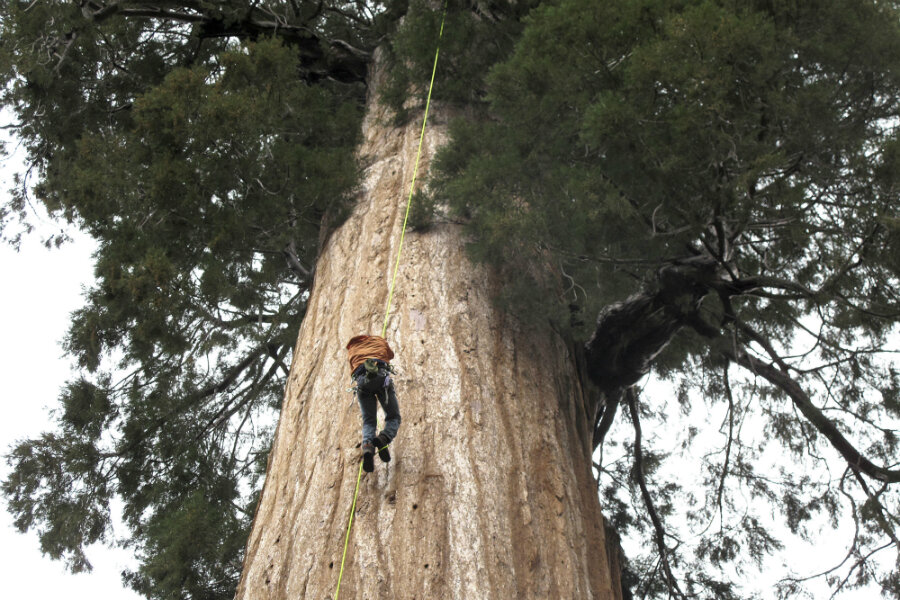How ancient sequoias may hold a key to reversing climate change
Loading...
Planting more trees to absorb carbon is one of the many ways that humans are working to combat climate change across the world – as evidenced by "carbon sink" planting efforts to meet zero net emissions, or the recent tree planting initiative in India. But meticulously collecting samples from ancient sequoia trees to then clone them in a lab and replant them throughout the world, well, that is a bit more of a novelty.
But that's the task being undertaken by the Archangel Ancient Tree Archive, a group of largely volunteer arborists and tree climbers who collect genetic samples from trees, clone them, and then plant them around the world as "a global warming solution."
And they put particular hope in the sequoia, native only to the western slopes of the Sierra Nevada Mountains of California. The group says that the genetics of these trees, which grow to be some 300 feet tall and 3,000 years old, may make them particularly suited to withstand and push back against climate change.
"It's really a race against time," David Milarch, co-founder of the project, told the Associated Press. "If we start right now, we can go after climate change and reverse it before it's too late."
On a recent trip to California's Sierra Nevada region, a volunteer group of about a dozen expert tree climbers scaled the area's massive sequoias and redwoods to collect samples from new growths. The samples were then transported back to the Archangel lab in Copemish, Mich., where they were snipped into roughly 2,000 shoots and 1,000 pieces of greenery and placed into jars with mixtures of peat and gel, and gel and growth hormones, respectively.
The samples were then placed in a lab with carefully maintained conditions to stimulate growth, but certainly not all will make it. The team hopes to return west later this year with up to 1,000 sequoia and redwood saplings to plant in Oregon.
"It's a biological miracle," said tree climber Jim Clark, who collected samples on the recent trip and transported them from California back to Michigan. "This piece of tissue ... can be rooted, and we have a miniature 3,000-year-old tree."
The nonprofit group takes the extra step of cloning, instead of just planting new trees, in order to preserve existing trees' genetic make-up and propagate the genes that have produced success. And while they have cloned 170 types of trees and planted more than 300,000 of them in seven countries, Mr. Milarch believes that both the size and hardiness of the sequoia trees will make them ideal for absorbing greenhouse gases.
While that theory has yet to be articulated by scientific research – and has received pushback from researchers who don't believe such targeted, small-scale work will make an impact – research and observation have shown the sequoia to be resilient in the face of drought, one of the current symptoms of climate change in California.
Resilience to drought is important for these trees, because full grown sequoias use up nearly 800 gallons of water each day during growing season to nourish their trunk, branches, and nearly 2 billion leaves. And research coming out the University of California, Berkeley, has shown the tree has mechanisms to resist at least moderate levels of drought: by shutting down their stomata, or pores in their leaves, they are able to essentially live on stored water.
And while the sequoias appeared to thrive during California's drought in the 1970s, actually growing faster in that period, scientists worry about the effects of a sustained drought and a diminished Sierra Nevada snowpack that hydrates the trees, combined with the record-breaking temperatures in recent years.
Speaking about how the sequoias have been adapting to draught conditions in an interview with The Christian Science Monitor last year, Nathan Stephenson with the US Geological Survey said, "The sequoias are holding up, they are being smart. They are adapting and purposely reducing their water demand."
While there are sequoia who have been hit by life-threatening fungal disease, the main cause of death for the trees is not environmental. Instead it's a trait that seemingly represents the robustness of these trees, lauded by Milarch and his Archangel team: the trees meet their end by growing so tall that they topple over.
As researchers continue to uncover how these trees function and utilize water, the jury remains out on whether the massive sequoias and their relatives will prove adept at combatting climate change – either for themselves or with an impact on the bigger picture.
However, some experts feel that the work being done to spread these trees is progress in and of itself.
Says Monterey-based horticulture consultant Bill Werner, who has worked with the Archangel Ancient Tree Archive: "It may be a drop in the bucket, but at least somebody's doing something."
This report includes material from the Associated Press.







